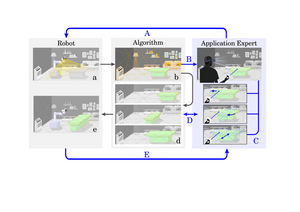Publications
Selected Publications
This page shows selected publications from the last years. For a detailed list please refer to the Google Scholar or DBLP page of Stefan Schneegass.

Type of Publication: Article in Journal
Keep the Human in the Loop: Arguments for Human Assistance in the Synthesis of Simulation Data for Robot Training
- Author(s):
- Liebers, Carina; Megarajan, Pranav; Auda, Jonas; Stratmann, Tim C; Pfingsthorn, Max; Gruenefeld, Uwe; Schneegass, Stefan
- Title of Journal:
- Multimodal Technologies and Interaction
- Volume (Publication Date):
- 8 (2024)
- pages:
- 18
- Digital Object Identifier (DOI):
- doi:10.3390/mti8030018
- Fulltext:
- <a href="/fileadmin/fileupload/I-HCI/KeepTheHumanInTheLoop.pdf" class="pdf">Keep the Human in the Loop: Arguments for Human Assistance in the Synthesis of Simulation Data for Robot Training (2.96 MB)</a>
- Link to complete version:
- https://www.mdpi.com/2414-4088/8/3/18
- Citation:
- Download BibTeX
Abstract
Robot training often takes place in simulated environments, particularly with reinforcement learning. Therefore, multiple training environments are generated using domain randomization to ensure transferability to real-world applications and compensate for unknown real-world states. We propose improving domain randomization by involving human application experts in various stages of the training process. Experts can provide valuable judgments on simulation realism, identify missing properties, and verify robot execution. Our human-in-the-loop workflow describes how they can enhance the process in five stages: validating and improving real-world scans, correcting virtual representations, specifying application-specific object properties, verifying and influencing simulation environment generation, and verifying robot training. We outline examples and highlight research opportunities. Furthermore, we present a case study in which we implemented different prototypes, demonstrating the potential of human experts in the given stages. Our early insights indicate that human input can benefit robot training at different stages.
